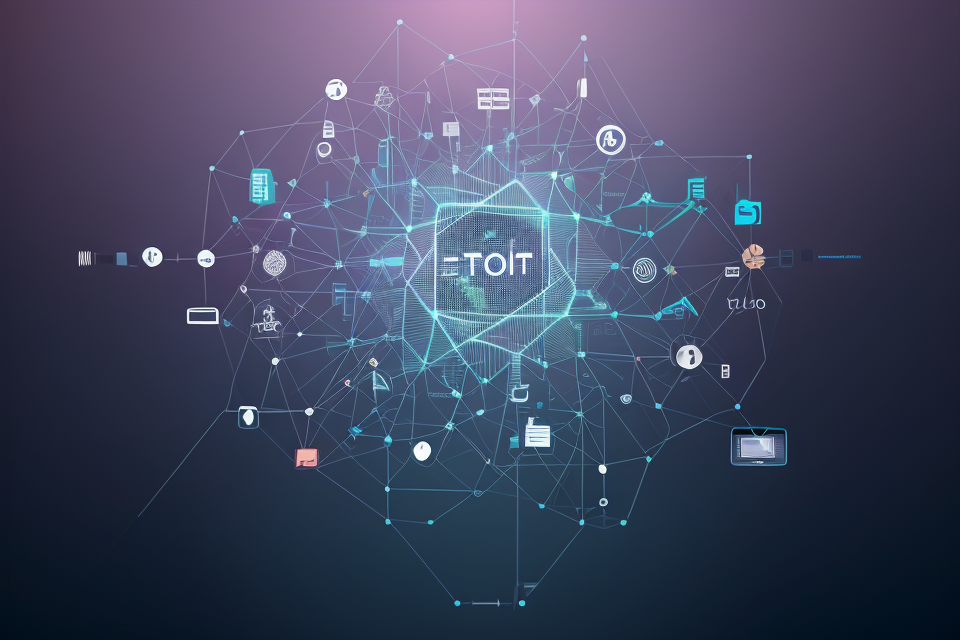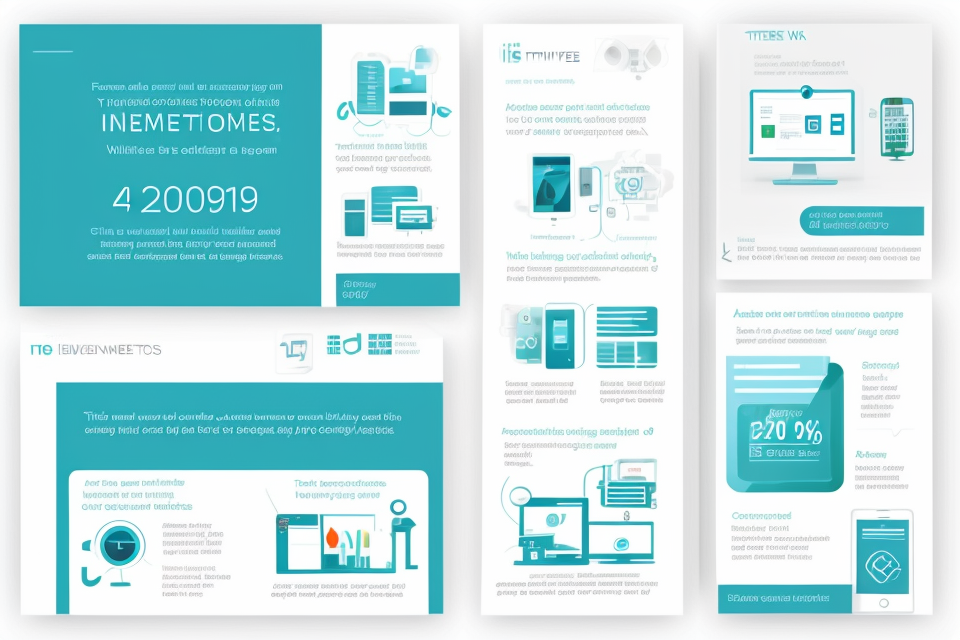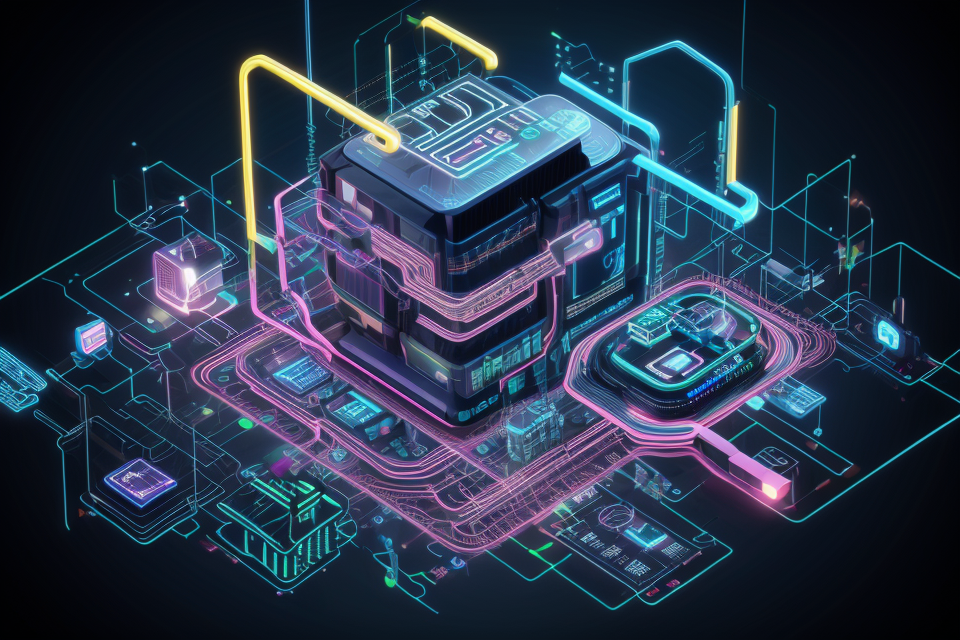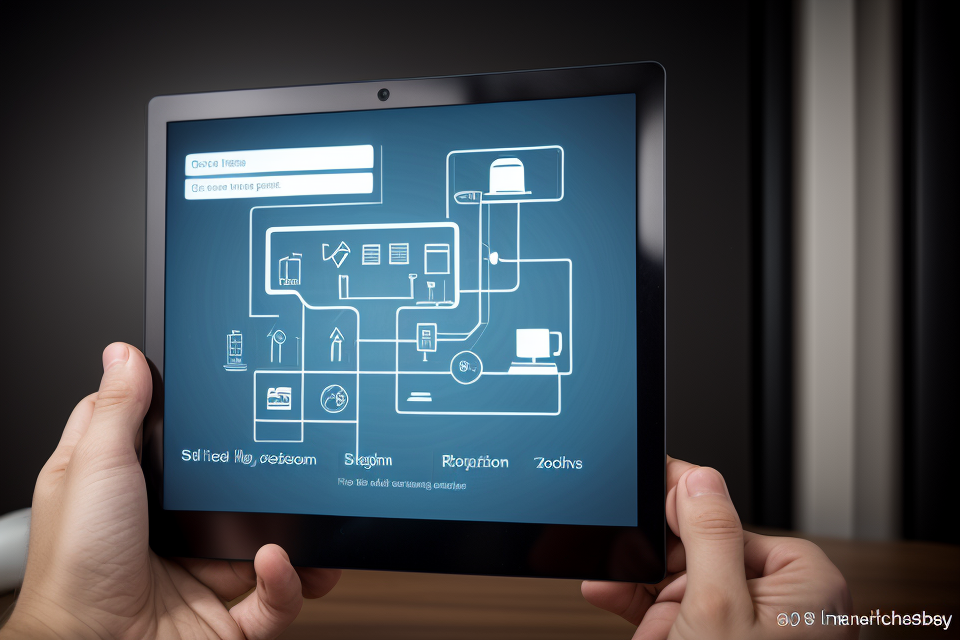The Internet of Things (IoT) is a term that has become increasingly prevalent in recent years, as more and more devices become connected to the internet. But who first coined the term, and how has the concept evolved over time? In this article, we’ll explore the origins of the IoT, and how it has developed into the ubiquitous technology it is today. From its earliest beginnings to the latest advancements, we’ll delve into the history of the IoT and discover who defined this revolutionary concept.
The Emergence of the Internet of Things
The Origin of the Term “Internet of Things”
The term “Internet of Things” was first coined by Kevin Ashton, a British technology pioneer, in 1999. Ashton, who was then working at Proctor & Gamble, was tasked with finding a way to track the company’s shipping containers in real-time. He proposed using sensors and the internet to create a network of connected devices that could communicate with each other and share data.
However, the idea of connecting everyday objects to the internet was not new. It was built on the work of several researchers and technologists who had been exploring the concept of networked devices for years. Vint Cerf and Robert Kahn, the creators of the TCP/IP protocol, had envisioned a world where all devices could be connected to the internet and communicate with each other.
Ashton’s contribution was to take this idea and apply it to a specific problem – the tracking of shipping containers. He saw the potential for the internet to connect not just computers and servers, but a wide range of everyday objects, from appliances to vehicles to industrial equipment. In his 1999 paper, “Internet of Things,” Ashton wrote:
“If we could afford the communication infrastructure to support it, we could extend the ‘net to every device with a switch or a power supply. Imagine it: a global network of computers, sensors, and actuators, all linked via the internet.”
Ashton’s vision of a network of connected devices has since become a reality, with the Internet of Things (IoT) becoming one of the most significant technological trends of the 21st century. Today, IoT is transforming industries from healthcare to manufacturing to transportation, and it is expected to have a profound impact on the way we live and work in the years to come.
The Development of the Internet of Things
The Development of the Internet of Things
The concept of the Internet of Things (IoT) has evolved significantly since its inception. It is essential to understand the factors that contributed to its development to appreciate its current state and future potential. This section will delve into the key drivers behind the growth of IoT, including technological advancements, the impact of Industry 4.0, and the proliferation of smart devices.
The Influence of Technological Advancements
Technological advancements have played a pivotal role in the development of IoT. The evolution of sensors, wireless communication technologies, and computing power have enabled the seamless connection of devices and the exchange of data. These advancements have allowed for the creation of intelligent systems that can monitor, analyze, and control various aspects of our lives.
For example, the emergence of low-cost sensors and microcontrollers has made it possible to embed intelligence into everyday objects, enabling them to communicate with each other and with centralized systems. Additionally, the widespread adoption of Wi-Fi, Bluetooth, and cellular networks has facilitated the exchange of data between devices, allowing for real-time monitoring and control.
The Impact of Industry 4.0
The concept of Industry 4.0 has also significantly contributed to the development of IoT. The integration of digital technologies into manufacturing processes has transformed the way businesses operate, leading to increased efficiency, productivity, and innovation. IoT has enabled the creation of smart factories, where machines and devices are connected and can communicate with each other, resulting in better resource management and reduced downtime.
Moreover, Industry 4.0 has facilitated the adoption of predictive maintenance, which allows for the proactive identification and resolution of potential issues, reducing unplanned downtime and increasing the lifespan of equipment. The integration of IoT in manufacturing has also enabled the collection of vast amounts of data, which can be used to optimize processes and improve product quality.
The Growth of Smart Devices
The growth of smart devices has also been a significant driver in the development of IoT. The proliferation of smartphones, smartwatches, and other connected devices has created a demand for seamless connectivity and integration with other devices. This has led to the development of platforms and ecosystems that allow for the communication and exchange of data between devices, enabling users to access and control various aspects of their lives through a single interface.
Moreover, the growth of smart home devices, such as smart thermostats, smart lighting systems, and smart security systems, has made it possible to create intelligent and connected environments. These devices can be controlled remotely, monitored in real-time, and can learn from user behavior to optimize their performance.
In conclusion, the development of IoT has been driven by a combination of technological advancements, the impact of Industry 4.0, and the growth of smart devices. These factors have created a landscape where devices can communicate with each other, exchange data, and provide insights that can be used to optimize processes and improve the quality of our lives. As IoT continues to evolve, it is expected to play an increasingly important role in shaping the future of technology and society.
Understanding the Internet of Things
The Internet of Things Explained
The Internet of Things (IoT) is a network of physical devices, vehicles, buildings, and other items embedded with electronics, software, sensors, and connectivity to enable these objects to collect and exchange data. This emerging technology has gained significant attention in recent years, with the number of IoT devices projected to reach 75 billion by 2025.
The Connection between Devices
In the IoT ecosystem, devices are interconnected through the internet, allowing them to communicate and share data with each other. This connection is facilitated by a range of technologies, including Wi-Fi, Bluetooth, and cellular networks. These connections enable devices to work together to provide a seamless user experience and enable new applications and services.
The Flow of Data
Data is the lifeblood of the IoT, and the flow of information between devices is critical to its operation. In the IoT, data is generated by sensors and other devices, which collect information about the environment, user behavior, and other factors. This data is then transmitted to other devices or the cloud for analysis, storage, and processing. The insights derived from this data can be used to optimize processes, improve efficiency, and create new value for businesses and consumers.
The Role of Protocols
Protocols are the rules that govern the communication between devices in the IoT. These protocols ensure that data is transmitted accurately and securely, and that devices can work together seamlessly. Some of the most common IoT protocols include MQTT, CoAP, and HTTP. As the IoT continues to evolve, new protocols and standards will emerge to address the challenges and opportunities of this emerging technology.
Applications of the Internet of Things
Smart Homes
The Benefits of Smart Home Technology
Smart home technology has revolutionized the way we live, offering numerous benefits to homeowners. Some of the key benefits of smart home technology include:
- Energy Efficiency: Smart home technology allows homeowners to monitor and control their energy usage, enabling them to reduce their energy bills and their carbon footprint. Smart thermostats, for example, can learn the homeowner’s temperature preferences and adjust the temperature accordingly, resulting in energy savings.
- Increased Security: Smart home technology can also increase security by providing homeowners with real-time alerts when doors or windows are opened, and by enabling them to monitor their homes remotely. Smart doorbells with cameras, for instance, allow homeowners to see who is at the door, even when they are not at home.
- Enhanced Comfort: Smart home technology can also enhance comfort by providing homeowners with more control over their environment. For example, smart lighting systems can be programmed to adjust the lighting levels in response to natural light, while smart heating and cooling systems can adjust the temperature based on the time of day and the weather.
The Challenges of Smart Home Technology
While smart home technology offers many benefits, it also presents some challenges. Some of the key challenges of smart home technology include:
- Cost: Smart home technology can be expensive to install and maintain, and may require significant upfront costs.
- Compatibility: Smart home technology may not be compatible with all devices and systems, which can make it difficult to integrate with existing systems.
- Privacy: Smart home technology can also raise privacy concerns, as it may collect and store personal data about homeowners and their habits.
Despite these challenges, smart home technology is becoming increasingly popular, and is expected to continue to grow in the coming years. As technology continues to evolve, it is likely that smart home technology will become more affordable, more compatible, and more secure, making it an attractive option for homeowners who want to enhance their comfort, security, and energy efficiency.
Smart Cities
Smart cities are one of the most significant applications of the Internet of Things (IoT). They are cities that use advanced technology to improve the quality of life for their citizens. In a smart city, sensors and connected devices are used to collect data on everything from traffic patterns to energy consumption. This data is then analyzed to optimize the city’s infrastructure and services.
The Benefits of Smart City Technology
The benefits of smart city technology are numerous. One of the most significant benefits is improved efficiency. By collecting data on how the city is functioning, officials can identify areas where improvements can be made. For example, they can identify traffic congestion and adjust traffic signals to reduce congestion. They can also identify areas where energy is being wasted and take steps to reduce consumption.
Another benefit of smart city technology is improved safety. By using sensors to monitor traffic patterns, officials can identify areas where accidents are likely to occur and take steps to prevent them. They can also use cameras and other sensors to monitor crime and respond more quickly to potential threats.
The Challenges of Smart City Technology
While smart city technology offers many benefits, there are also challenges that must be addressed. One of the biggest challenges is privacy. As sensors and connected devices collect data on everything from traffic patterns to personal behavior, there is a risk that this data could be used to monitor individuals’ activities.
Another challenge is security. As smart city systems become more complex, there is a risk that they could be hacked or otherwise compromised. This could have serious consequences, such as disrupting traffic flow or causing power outages.
Overall, while smart city technology offers many benefits, it is important to address the challenges associated with it in order to ensure that it is implemented in a way that is safe, secure, and respects individuals’ privacy.
Industrial Applications
The Benefits of Industrial IoT
The Industrial Internet of Things (IIoT) refers to the use of IoT technology in industrial settings. IIoT has the potential to revolutionize industrial processes, improve efficiency, and reduce costs. Some of the benefits of IIoT include:
- Improved efficiency: IIoT devices can collect and analyze data in real-time, enabling companies to optimize their processes and reduce waste.
- Predictive maintenance: By analyzing data from sensors, IIoT can predict when equipment is likely to fail, allowing companies to schedule maintenance before a breakdown occurs.
- Enhanced safety: IIoT can be used to monitor conditions in hazardous environments, such as factories and oil rigs, and alert workers to potential dangers.
The Challenges of Industrial IoT
While IIoT offers many benefits, there are also several challenges that must be addressed. Some of the challenges of IIoT include:
- Security: IIoT devices are vulnerable to cyber attacks, and securing these devices can be a significant challenge.
- Data management: IIoT generates vast amounts of data, and managing this data can be a complex and time-consuming task.
- Interoperability: IIoT devices are often made by different manufacturers, which can make it difficult to ensure that they can communicate with each other.
Despite these challenges, the adoption of IIoT is growing rapidly, and it is expected to have a significant impact on industrial processes in the coming years.
The Future of the Internet of Things
Predictions for the Internet of Things
Market Growth
The market for the Internet of Things (IoT) is expected to continue to grow rapidly in the coming years. According to a report by ResearchAndMarkets.com, the global IoT market is projected to reach $1.6 trillion by 2022, with a compound annual growth rate (CAGR) of 28.5% from 2017 to 2022. This growth can be attributed to the increasing demand for smart devices and the need for better connectivity and automation in various industries.
Technological Advancements
The evolution of technology will play a significant role in the growth of the IoT market. Advancements in areas such as artificial intelligence (AI), machine learning (ML), and edge computing will enable more sophisticated and efficient IoT systems. For example, AI-powered IoT devices can learn from data and make predictions, while edge computing can reduce the need for data to be sent to the cloud, leading to faster processing and lower latency. These advancements will drive the development of new applications and use cases for the IoT, further fueling market growth.
Potential Impact on Society
The Internet of Things (IoT) has the potential to significantly impact society in various ways. Some of the potential impacts on society include:
Improved Efficiency
The IoT can help improve efficiency in various industries such as agriculture, transportation, and energy. For example, in agriculture, IoT sensors can be used to monitor soil moisture levels, crop health, and weather conditions, allowing farmers to make data-driven decisions about when to plant, irrigate, and harvest crops. This can lead to increased productivity and reduced waste.
Enhanced Safety and Security
The IoT can also enhance safety and security in various settings such as homes, offices, and public spaces. For example, IoT sensors can be used to detect and alert people of potential hazards such as fires, gas leaks, and intruders. This can help prevent accidents and reduce crime rates.
Increased Accessibility
The IoT can also increase accessibility for people with disabilities. For example, IoT devices such as smart homes and assistive technologies can help people with mobility impairments to control their environment and communicate with others more easily.
New Job Opportunities
The IoT is also expected to create new job opportunities in various fields such as software development, data analysis, and cybersecurity. As more devices become connected to the internet, there will be a growing need for people to design, develop, and maintain these devices and the systems that support them.
Privacy Concerns
Despite its potential benefits, the IoT also raises privacy concerns. As more devices become connected to the internet, there is a risk that personal data could be accessed and used without consent. This could lead to privacy violations and identity theft. It is important for individuals and organizations to be aware of these risks and take steps to protect their data.
Environmental Impact
The IoT can also have an environmental impact. The production, use, and disposal of IoT devices require energy and resources, which can contribute to carbon emissions and electronic waste. It is important for individuals and organizations to consider the environmental impact of their IoT devices and take steps to reduce their environmental footprint.
Ethical Considerations
As the Internet of Things (IoT) continues to advance and integrate into various aspects of our lives, it is essential to consider the ethical implications of this technology. Some of the key ethical considerations for the IoT include data privacy and algorithmic bias.
Data Privacy
Data privacy is a critical concern when it comes to the IoT. With the increasing amount of personal and sensitive data being collected and shared by connected devices, there is a growing risk of data breaches and cyber attacks. Furthermore, the use of the IoT in public spaces raises questions about who has access to the data being collected and how it is being used.
To address these concerns, it is essential to develop robust data protection and privacy regulations that apply to the IoT. This includes measures such as data encryption, secure data storage, and clear policies on data access and usage.
Algorithmic Bias
Another ethical consideration for the IoT is algorithmic bias. As more and more data is collected and analyzed by the IoT, there is a risk that the algorithms that power the technology will perpetuate existing biases and discrimination.
For example, if facial recognition technology is used in law enforcement, there is a risk that the algorithms used to identify individuals may be biased against certain groups of people. This could lead to false positives and unjust treatment of individuals.
To address this issue, it is essential to ensure that the development and deployment of the IoT is guided by principles of fairness and transparency. This includes developing algorithms that are free from bias and providing clear and accessible information about how the technology works.
In conclusion, the ethical considerations of the IoT are complex and multifaceted. It is essential to address these concerns proactively to ensure that the technology is developed and deployed in a way that is safe, fair, and transparent.
Challenges and Opportunities
Infrastructure Requirements
The Internet of Things (IoT) is poised to revolutionize the way we live and work, but it also presents significant challenges. One of the most pressing issues is the need for new infrastructure to support the vast array of connected devices. This includes not only the physical infrastructure such as networks and servers, but also the software and security systems that are necessary to ensure that the data being transmitted is secure and protected from cyber threats.
Job Market Transformation
The IoT is also likely to have a significant impact on the job market. As more and more devices become connected, there will be a growing need for experts in fields such as data science, software engineering, and cybersecurity. However, there will also be a need for workers in other areas, such as manufacturing and logistics, to adapt to the new technologies and workflows that the IoT will bring.
Another challenge that the IoT presents is the need for standardization. As more and more devices become connected, it will become increasingly important to ensure that they are all able to communicate with each other seamlessly. This will require the development of new standards and protocols, which will need to be adopted by manufacturers and other stakeholders in the industry.
Finally, there is the issue of privacy and security. As more and more data is collected by connected devices, there is a growing concern about how this data will be used and protected. This will require the development of new privacy and security standards, as well as greater transparency from companies about how they collect and use data.
Despite these challenges, the IoT also presents significant opportunities. For example, the IoT has the potential to improve efficiency and productivity in a wide range of industries, from manufacturing and logistics to healthcare and agriculture. It can also help to improve the quality of life for individuals, by providing new tools for monitoring and managing their health and well-being.
In addition, the IoT has the potential to drive economic growth and create new jobs in a range of fields. It will also provide new opportunities for innovation and entrepreneurship, as new products and services are developed to take advantage of the new technologies and capabilities that the IoT enables.
Overall, while the IoT presents significant challenges, it also offers tremendous opportunities for growth and innovation. As the technology continues to evolve and mature, it will be important for businesses, governments, and individuals to work together to ensure that it is developed in a way that maximizes its potential benefits while minimizing its risks.
FAQs
1. Who defined the term “Internet of Things”?
The term “Internet of Things” was first coined by Kevin Ashton, a British technologist and author, in 1999. Ashton was working at Procter & Gamble at the time, and he used the term to describe a system of interconnected devices that could communicate with each other and exchange data without human intervention.
2. How did the concept of the Internet of Things evolve?
The concept of the Internet of Things has evolved significantly since it was first introduced. Initially, the focus was on connecting basic devices such as household appliances and automobiles to the internet. However, as technology has advanced, the scope of the Internet of Things has expanded to include a wide range of devices, from wearable technology to industrial machinery. Today, the Internet of Things is a rapidly growing field that is transforming industries such as healthcare, transportation, and manufacturing.
3. What are some examples of the Internet of Things in use today?
There are many examples of the Internet of Things in use today. Some of the most common include:
* Smart home devices such as thermostats, light bulbs, and security cameras
* Wearable technology such as fitness trackers and smartwatches
* Connected cars that can communicate with each other and with the infrastructure around them
* Industrial machinery that can be monitored and controlled remotely
* Healthcare devices such as implantable medical devices and remote patient monitoring systems
4. What are the benefits of the Internet of Things?
The Internet of Things has the potential to revolutionize many industries and improve the way we live and work. Some of the benefits of the Internet of Things include:
* Increased efficiency: The Internet of Things can automate many tasks and processes, reducing the need for human intervention and increasing efficiency.
* Improved safety: Many devices and systems can be monitored and controlled remotely, reducing the risk of accidents and improving safety.
* Enhanced convenience: The Internet of Things can make many tasks easier and more convenient, such as controlling home devices with voice commands or tracking fitness goals with wearable technology.
* New business opportunities: The Internet of Things is creating new business opportunities and driving innovation in many industries.
5. What are the challenges of the Internet of Things?
While the Internet of Things has many potential benefits, there are also several challenges that must be addressed. Some of the challenges of the Internet of Things include:
* Security: As more devices are connected to the internet, the risk of cyber attacks and data breaches increases.
* Interoperability: Different devices and systems may use different standards and protocols, making it difficult to ensure that they can communicate with each other.
* Privacy: The Internet of Things can collect a lot of personal data, raising concerns about privacy and data protection.
* Cost: Implementing the Internet of Things can be expensive, particularly for small businesses and individuals.



